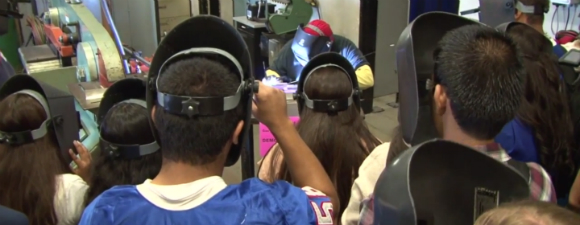
Welding demonstration at Cerritos College. (Photo Credit: John Guenther)
As the FIFA World Cup commences in Sao Paulo, Brazil the battle isn’t limited to just the soccer field. For months, young Brazilians have been protesting the tournament coming claiming that its arrival is taking away funding from other important services throughout the country; one of those is job creation.
Despite Brazil’s 5 percent unemployment rate, which is a record breaking low, the residents are still concerned that they won’t have sustainable employment in the future; and they are just a few of millions worldwide.
Currently there’s an estimated 290 million people ages 15-24 that are either jobless or not enrolled in an educational program. That number correlates to 40 percent of the world’s population under the age of 25 being unemployed.
Here in California the number of unemployed from a similar age range had reached 20.2 percent in 2012, more than double the overall-statewide rate at the time, according to the Bureau of Labor Statistics.
However, young people are being affected by this downturn in economic opportunity in more ways than just the obvious.
In January 2014, the non-profit organization Young Invincibles released a report entitled, “In This Together: The Cost of Young Adult Unemployment” highlighting unconventional challenges that are occurring due lack of job prospects for the youth workforce.
The report states that all generations are baring the brunt of a struggling workforce, with everything from increased expenditures on unemployment insurance to significantly decreased tax revenue. In California alone, the cumulative costs of youth unemployment resulted in an estimated $219 million in losses for the state.
“There’s been a grim personal reality for a lot of young people coming into the work force and looking for a job,” Tom Allison said. “When you’re confronted with a job market that isn’t providing middle wage jobs you’re going to have trouble doing a lot of things. You’re expected to get a positive return on your investment, but the jobs just aren’t there.”
In addition to serving as the policy and research manager at the Young Invincibles, Allison is one of the three authors who collaborated on the writing the youth unemployment report.
“Having the job market the way that it is leads to a lot of issues for young people in particular,” he continued. “It means that most likely that you’re going to have to defer starting a family, you’re probably going to rent instead of buying a house and it’ll essentially take longer to start really ‘living.’ Not being able to find a job is a huge life hindrance.”
And that’s where the importance of career technical education (CTE) comes in. As one of the fastest growing sectors in the US for job growth it’s become a great option for young people who feel that they have little or no opportunity.
“There are estimates that 65 percent percent of jobs will require some sort of secondary degree by 2020, whether that be bachelor’s, associates or technical and vocational,” Allison said. “So, as a country it’s important to know that these types must be supported and that they’re vital to the growth of the economy; especially in a state like California where those industries are increasing so rapidly.”
In California, of the more than 17 million jobs throughout the state, 14 percent of them centered on CTE-relevant trades. Additionally, the median wages of workers five years after award of an associate’s degree in a vocational discipline was $66,600 compared to $38,500 for those with non-vocational associate degrees. With the need for jobs growing amongst youth daily, CTE programs have become even more necessary than ever before.
In a short-term win for the effort, the recently passed state budget awaiting Governor Jerry Brown’s signature includes a $50-million, one-time boost to CTE programs at the California Community Colleges.
In addition to CTE programs serving as a solution, Allison also suggests that young people make the policymakers create more opportunities through public service programs.
“Programs like [community service project] Americorps are what we need to expand and support to not only get [young people] working, but also actively involved in their communities,” he said. “The faster that we increase those types of programs and produce more quality and affordable college degrees, the better off we’ll be, because at the end of the day education is the key.”

